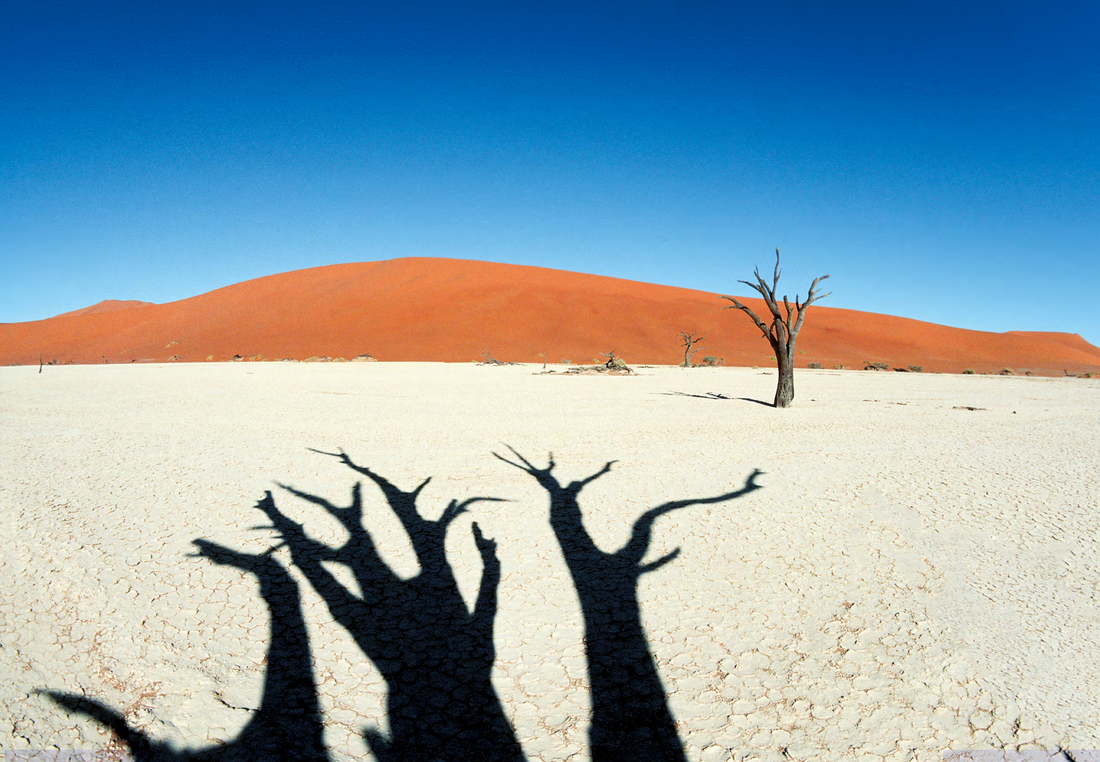
Dead Vlei disappearance
Share
If you have ever been to Dead Vlei close to Sossusvlei in Namibia, you will know that it is a place known for two things – haunting trees reaching out from the pale earth and pale tourists reaching for their cameras.
There are so many photographs taken of the vlei that it is almost impossible to be original. The emptiness and desolation of the place is so overwhelming that many avid photographers have captured the scenes, only to return home to find images identical to theirs published everywhere. For there are only a few images that one can take of the place.
It is only the obsessive photographer who goes back time after time, who manages to look past this barrier of predictability and capture an original image of this well-photographed scene.
Yet sometimes it is not only the obsessive but also the forgetful who get it right. In this case, me.
While photographing for Art of Nature, I walked down the long, sandy track to Dead Vlei with a bag full of all the equipment I would need. Or so I thought.
I had visualized what images I would take of the vlei, using my 16-35mm lens, and knew exactly what I wanted. When I arrived, I immediately dropped my camera bag to the ground and took out my camera.
I dug through the bag but couldn’t find my 16-35mm lens. It had disappeared. (It was probably still in the vehicle.)
If you have ever been to Dead Vlei, you will know that to jog back to your vehicle for a lens is not wise, because by the time you’ve fetched it and returned to the Vlei, the light will have gone and your legs will be jelly.
So I had to shoot with what I had. On closer inspection, I discovered that the only wide lens I had with me was my 15mm fisheye. This was a disaster because the fisheye lens tends to distort landscapes terribly.
But I persevered. First I photographed the landscape with the horizon a third from the bottom, but it was severely distorted and looked totally unnatural. After experimenting for a while, I discovered that if I placed the horizon in the centre of the image, it did not distort at all. Also, subjects further away from the lens tended to be distorted far less than subjects close to the lens.
I aimed into the sun and this created a pleasing image, as the fisheye lens is so wide that the sun was tiny in the frame and could be an enhancing element of the image. But the image that I saw and wanted to take was with front lighting, shooting towards the dunes to get the vivid orange, blue and white colours. The problem was that the lens was so wide that as soon as I aimed with the sun, I saw my own shadow in the viewfinder. It didn’t matter what I tried, my shadow was always there.
So I “made a plan” and stood at the base of one of the dead trees. This worked, because not only did I manage to hide my own shadow in the shadow of the tree, but the tree shadow also produced a pleasing black, crack-like shape spreading from the base of the image and leading up into it. The image worked because it was different. Photography is not about what equipment you take along – it’s about what you do with the equipment you didn’t forget.
There are so many photographs taken of the vlei that it is almost impossible to be original. The emptiness and desolation of the place is so overwhelming that many avid photographers have captured the scenes, only to return home to find images identical to theirs published everywhere. For there are only a few images that one can take of the place.
It is only the obsessive photographer who goes back time after time, who manages to look past this barrier of predictability and capture an original image of this well-photographed scene.
Yet sometimes it is not only the obsessive but also the forgetful who get it right. In this case, me.
While photographing for Art of Nature, I walked down the long, sandy track to Dead Vlei with a bag full of all the equipment I would need. Or so I thought.
I had visualized what images I would take of the vlei, using my 16-35mm lens, and knew exactly what I wanted. When I arrived, I immediately dropped my camera bag to the ground and took out my camera.
I dug through the bag but couldn’t find my 16-35mm lens. It had disappeared. (It was probably still in the vehicle.)
If you have ever been to Dead Vlei, you will know that to jog back to your vehicle for a lens is not wise, because by the time you’ve fetched it and returned to the Vlei, the light will have gone and your legs will be jelly.
So I had to shoot with what I had. On closer inspection, I discovered that the only wide lens I had with me was my 15mm fisheye. This was a disaster because the fisheye lens tends to distort landscapes terribly.
But I persevered. First I photographed the landscape with the horizon a third from the bottom, but it was severely distorted and looked totally unnatural. After experimenting for a while, I discovered that if I placed the horizon in the centre of the image, it did not distort at all. Also, subjects further away from the lens tended to be distorted far less than subjects close to the lens.
I aimed into the sun and this created a pleasing image, as the fisheye lens is so wide that the sun was tiny in the frame and could be an enhancing element of the image. But the image that I saw and wanted to take was with front lighting, shooting towards the dunes to get the vivid orange, blue and white colours. The problem was that the lens was so wide that as soon as I aimed with the sun, I saw my own shadow in the viewfinder. It didn’t matter what I tried, my shadow was always there.
So I “made a plan” and stood at the base of one of the dead trees. This worked, because not only did I manage to hide my own shadow in the shadow of the tree, but the tree shadow also produced a pleasing black, crack-like shape spreading from the base of the image and leading up into it. The image worked because it was different. Photography is not about what equipment you take along – it’s about what you do with the equipment you didn’t forget.
